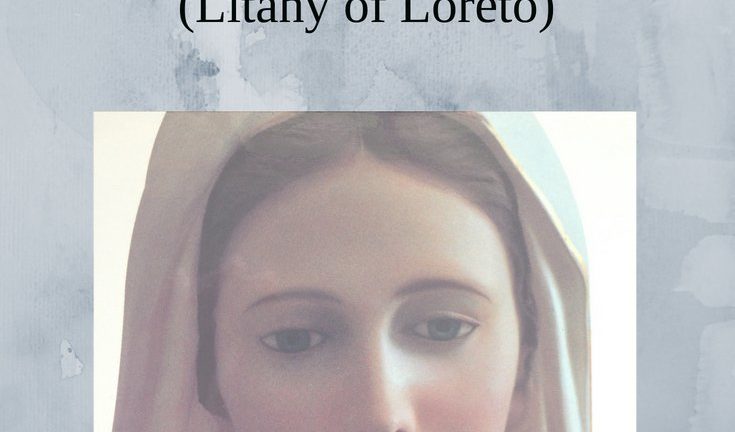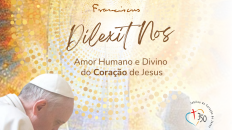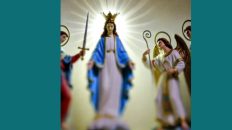Many Catholics usually say the Litany of Our Lady after the Rosary, but few are well aware of the great theological and symbolic values of their invocations. While several of the invocations are obvious nor would they need any explanation; however, many Catholics would find a hard time understanding many of the invocations, such as: “Tower of David”, “Mirror of Justice”, “Seat of Wisdom”, “House of Gold”, etc. Why “Tower of David” and not “Tower of Abraham or Moses?” Why “Mirror of Justice?” What connection does our Lady have with all these titles? What is the origin of these invocations? Wouldn’t it be spiritually more beneficial to invoke her titles knowing their meanings? Therefore, as we journey through this Marian month of May, we shall explain briefly the meaning of these titles. Before delving into the meaning, it is pertinent to consider its origin and composition.
The word litany is derived from the Latin ‘litania’, which springs from Ancient Greek ‘λιτανεία’ (litaneía) coming from λιτή (litê), meaning “supplication”. Litany, in Christian worship and some forms of Judaic worship, is a form of prayer used in services and processions and consisting of a number of petitions. It is a kind of call-and-response prayer, where invocations and supplications uttered by the person leading the prayer are answered by the congregation. The most notable use of litanies in Jewish liturgy are during the “Ten Days of Repentance.” The Ten Days of Repentance are the days between ‘Rosh Hashana’ (the Jewish New Year) and ‘Yom Kippur’ (The Day of Atonement). Therefore, during this period, ‘supplicatory prayers’ (litanies) such as ‘Avinu Malkeinu,’ are recited during the ‘Rosh Hashanah’ and ‘Yom Kippur’ liturgies. Also, certain ‘Selichot’ prayers also take the form of a litany during the Jewish month of Elul.
From the foregoing, it becomes clear why the Church (carved out from Judaism) since its earliest times prays in a litany-like (supplication – call and response prayer) form. This is seen in the faithful who went in procession to the different churches. There are, of course, numerous litanies, depending on what is requested in the various processions. One of the many litanies we have is that of the Blessed Virgin Mary, also known as Litany of Loreto.
The Litany of Loreto was composed by pilgrims. It all began in the year 1291, when the house in which Our Lady lived in Palestine was said to have miraculously transported to the city of Loreto (Italy), the happy news spread quickly, initiating numerous pilgrimages. As time went by, a series of pleas to Our Lady was composed by the pilgrims who went there to invoke her intercession. Subsequently, this litany was sung daily at the Sanctuary of Loreto, and the pilgrims who returned from there popularized it throughout the Catholic world overtime. This litany is called ‘lauretana’ because it has its origin in Loreto, Italy. It is also important to note that not all were composed in Loreto. Some invocations have been added by the Popes throughout the ages. Apparently, some extra invocations/titles are added by some regions to honour the protection of Our Lady or denote an affiliation to her but the central body of litanies remains the same.
In the light of its composition, we notice that at the beginning of the Lauretana, the invocations are not addressed to Our Lady, but to Our Lord and the Most Holy Trinity; for we say, Lord, have mercy on us, Christ, have mercy on us, etc., after which we invoke the Eternal Father, the Son and the Holy Spirit. Why is this so? Everything in Our Lady leads us to her divine Son, and through Him to the Most Holy Trinity, which is our ultimate end. This is something that non-Catholics do not understand or do not want to understand, for many of them see the Litany prayer already as a deviation, because to them, a lot of honour is given to Mary more than the Trinity, but they are wrong. After the introduction of the litany (to our Lord and the Trinity), three invocations follow, in which we pronounce the name of our Lady (Holy Mary) and remember two of her main privileges: being Mother of God and Virgin of Virgins. Next, there is a group of invocations to honour Our Lady’s Maternity, and another group of invocation to honour Her Virginity. Then, some invocations of her mercy and a group of invocations of her as a glorious and powerful Queen.
Obviously, the invocations with symbolic figures are quite difficult to understand. Probably, our civilization has become closed to symbolism, and what could even be evident in other times, today has been obscured by the exclusivity granted to the practical spirit. Contemporary life itself contributes to this. So, for example, it would be difficult to explain to a people who live in closed and dangerous cities, the beauty of a star or the significance of the moonlight, so also it is when we talk about some titles of our Lady in this modern age.
Therefore, my dear friends in Christ, I invite you to journey with me in these coming days of the month of May in understanding better her titles as contained in the litany.
Shalom!
© Fr. Chinaka Justin Mbaeri, OSJ
Paroquia Nossa Senhora de Fatima, Vila Sabrina, São Paulo, Brazil
nozickcjoe@gmail.com / fadacjay@gmail.com
+5511983250125
___________________________________
PS: Have you prayed your Rosary today?





Welcome to the Month of our Beloved Mother.
I pray for the Grace to be able to observe my complete the May Devotion, Amen
Well explained, thank you fr, our lady of Lorreto pray for us.
Ho
Holy Mary mother of God, pray for us
Blessed Mother please give me the strength to follow you diligently through out this month of May. Amen.
The exposition is quite explicit and mind opening. I have learned this today and hope for more . Thank you Father.
Mother of Divine Grace, pray for us Amen
Our Lady Queen of the Rosary pray for us
Eternal Father help me to follow you devotedly in this month of devotion to Mary the mother of God.
Thanks well understood
Thank you so very much padre, For the detail explanation of the ligtany. Seat of wisdom, pray for us.
AMEN!
Thank God for the month of May. The month of my birth.
Most Blessed Virgin Mary pray for us
May our Lady of Lourdes intercede for us in this month of May, amen
Welcome to the month of our Lady. May God hear and answer all our intentions this month. Amen
Thank God is another may devotion, Mother Mary please protect me and pave way for financial assistance for me through Jesus christ your son amen
Mary our mother, pray for us
Thanks Fr. for the teachings. May you be lifted!
O Mary Mother of God please intercede for me to your son that peace, joy, mercy, grace shall abide in my family. I pray for financial blessings for my children. Mother please help me I’m sad. Please let my prayers and petitions be granted Through Christ our Lord Amen
Thanks Padre, in this your wonderful explanations of our Lady’s Litany.
May Almighty God bless and give you unction to function in Jesus name. Amen
Oh sweet mother give me grace to journey with u dis month and beyond in jesus name
Thank you Padre
Thank you padre, may God continue to bless you more in Jesus name Amen.
Mary mother help me to observe my prayers this month and for eternity .
Oh sweet mother give me grace to journey with u dis month and beyond in jesus name amen
Virgin most pure, pray for us
“Everything in Our Lady leads us to her divine Son, and through Him to the Most Holy Trinity, which is our ultimate end.” We are grateful to God for giving us his beloved mother and our Mother also and for her unceasing intercession on our behalf.
Thank you so much for this beautiful reflection
Mary comforter of the afflicted pray for us
Our Lady of good counsel.. Pray for us
May our prayers be answered mightily through Christ our Lord Amen
Holy Mary, pray for us
Happy New Month of May
Saint Joseph spouse of Mary, pray us and bless the works of our hands. Amen
Mama please do for me and my family extraordinary miracles in this month of May and beyond.Amen.
Our lady of Loreto, pray for us to have the grace to observe thie May devotion faithfully and reap the benefits thereof, Amen!
Thanks so much Padre, for all you and your team are doing for us. May God bless you all and grant us the resources to support the continued functioning of this invaluable group.
Our Lady of Loreto, pray for us
Mother Mary, help me to be faithful to my prayers in this month of May. Amen
This is an eye opener to me and I’m happy to be part of it. Mary, mother of God and our mother, pray for us Amen
Thank you Fr.
May God grant us more understanding.
Amen
Aptly captured.May Our Lady of Perpetual Help continuously intercede for us.Amen
Fr. Thank God so much. May God continue to bless and strengthen you in your daily teachings and may our mother Mary continue to intercede for you and family.
Amen
May God grant me the grace not to miss a single day of the May Devotion in Jesus name
May our mother mary gives me the strength to be able to complete this May devotion in Jesus name
Holy Mary Mother of God
Pray for us
Very impactful, I appreciate this a lot.
This will help my prayer life. Thank you Padre.
AMEN .
Mother Mary, the lady of Loretta pray for intercede for me.
May Our Mother Mary continue to intercede for us through Jesus Christ our Lord Amen and Amen.
Oh dearest mother intercede for me and obtain for me the grace of divine healing Amen
Holy Mary Mother of God pray for me,Amen
Our Lady of Loreto. Pray for us